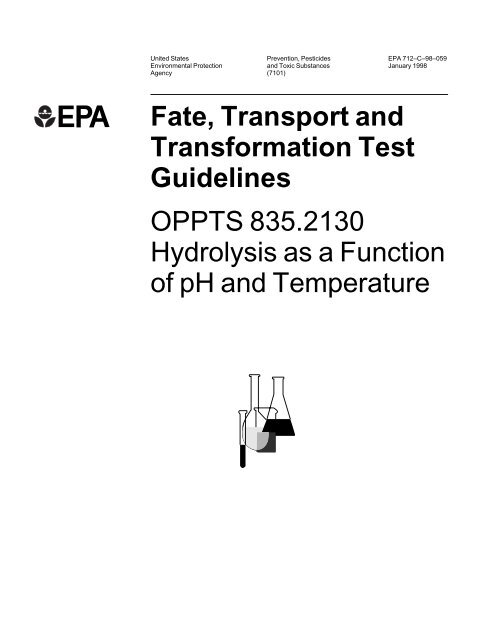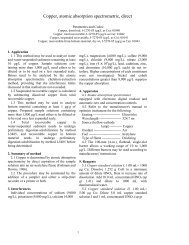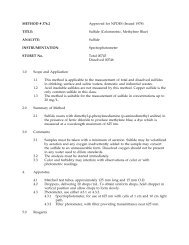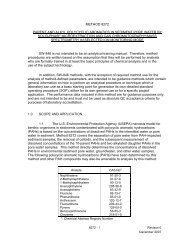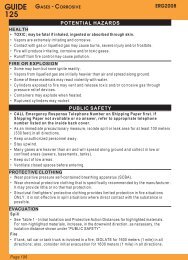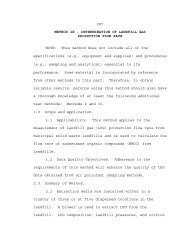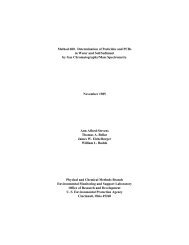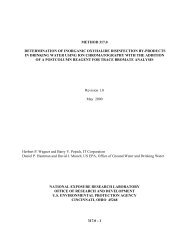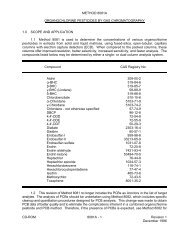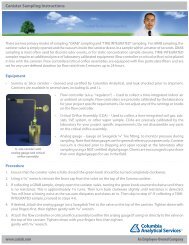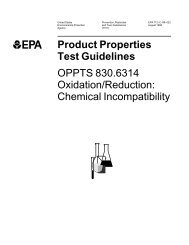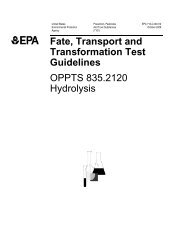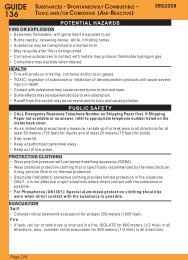View Actual EPA Method 835.2130 - Columbia Analytical Services
View Actual EPA Method 835.2130 - Columbia Analytical Services
View Actual EPA Method 835.2130 - Columbia Analytical Services
Create successful ePaper yourself
Turn your PDF publications into a flip-book with our unique Google optimized e-Paper software.
United StatesEnvironmental ProtectionAgencyPrevention, Pesticidesand Toxic Substances(7101)<strong>EPA</strong> 712–C–98–059January 1998Fate, Transport andTransformation TestGuidelinesOPPTS <strong>835.2130</strong>Hydrolysis as a Functionof pH and Temperature
INTRODUCTIONThis guideline is one of a series of test guidelines that have beendeveloped by the Office of Prevention, Pesticides and Toxic Substances,United States Environmental Protection Agency for use in the testing ofpesticides and toxic substances, and the development of test data that mustbe submitted to the Agency for review under Federal regulations.The Office of Prevention, Pesticides and Toxic Substances (OPPTS)has developed this guideline through a process of harmonization thatblended the testing guidance and requirements that existed in the Officeof Pollution Prevention and Toxics (OPPT) and appeared in Title 40,Chapter I, Subchapter R of the Code of Federal Regulations (CFR), theOffice of Pesticide Programs (OPP) which appeared in publications of theNational Technical Information Service (NTIS) and the guidelines publishedby the Organization for Economic Cooperation and Development(OECD).The purpose of harmonizing these guidelines into a single set ofOPPTS guidelines is to minimize variations among the testing proceduresthat must be performed to meet the data requirements of the U. S. EnvironmentalProtection Agency under the Toxic Substances Control Act (15U.S.C. 2601) and the Federal Insecticide, Fungicide and Rodenticide Act(7 U.S.C. 136, et seq.).Final Guideline Release: This guideline is available from the U.S.Government Printing Office, Washington, DC 20402 on The Federal BulletinBoard. By modem dial 202–512–1387, telnet and ftp:fedbbs.access.gpo.gov (IP 162.140.64.19), or call 202–512–0132 for disksor paper copies. This guideline is also available electronically in ASCIIand PDF (portable document format) from <strong>EPA</strong>’s World Wide Web site(http://www.epa.gov/epahome/research.htm) under the heading ‘‘Researchersand Scientists/Test <strong>Method</strong>s and Guidelines/OPPTS Harmonized TestGuidelines.’’i
OPPTS <strong>835.2130</strong> Hydrolysis as a function of pH and temperature.(a) Scope—(1) Applicability. This guideline is intended to meet testingrequirements of both the Federal Insecticide, Fungicide, andRodenticide Act (FIFRA) (7 U.S.C. 136, et seq.) and the Toxic SubstancesControl Act (TSCA) (15 U.S.C. 2601).(2) Background. The source material used in developing this harmonizedOPPTS test guideline are OPPT 796.3510, OPP 161–1 HydrolysisStudies, and OECD 111 Hydrolysis as a Function of pH.(b) Introduction—(1) Background and purpose. (i) The majorityof the earth’s surface is covered by water in the form of oceans, seas,rivers, lakes, streams, or ponds. As a result, chemical substances or mixturesreleased to the environment are likely to enter aqueous media andcould undergo transformation via hydrolysis. Hydrolysis represents thetransformation of a chemical substance by reaction with water into newchemicals different from their precursors. Certain classes of these substances,upon entering aquatic media, can undergo hydrolysis, which isone of the most common chemical reactions controlling stability and is,therefore, one of the principal chemical transformation pathways of thesesubstances in the environment.(ii) Since hydrolysis can be such an important chemical transformationpathway for certain classes of chemical substances, it is necessary,in assessing the fate of these chemicals in the environment, to knowwhether, at what rate, and under what conditions a substance will hydrolyze.Some of these reactions can occur so rapidly that there may be greaterconcern for the transformation products than for the parent substance.In other cases, a chemical substance will be resistant to hydrolysis undertypical environmental conditions, while in other instances, the substancemay have an intermediate stability that can result in the need for an assessmentof both the parent substance and the transformation products. Theimportance of abiotic hydrolysis in aqueous media in the environment canbe determined quantitatively from data on hydrolysis rate constants andhalf-lives.(iii) This test guideline was developed to determine hydrolysis rateconstants and half-lives of substances at any environmentally relevant pHand temperature anywhere in the United States.(2) Definitions and units. The following definitions apply to thisguideline:Hydrolysis is defined as a chemical reaction of an organic chemicalwith water such that one or more bonds are broken and the reaction productsincorporate the elements of water (H 2 O). This type of transformationoften results in the net exchange of the group X, in an organic chemicalsubstance RX, for the OH group from water. This reaction can be writtenas:1
Equation 1RX + HOH –––––––––> ROH + HXAnother result of hydrolysis can be the incorporation of both H and OHin a single product. An example of this reaction is the hydrolysis of anepoxide which can be represented by the reaction:Equation 2Elimination reaction means the reaction of an organic chemical substanceRX in water in which the X group (as HX) is lost. These reactionsgenerally follow the same type of rate laws that hydrolysis reactions follow,and, therefore, are also covered in this test guideline.First-order reaction means a reaction in which the rate of disappearanceof the test substance is directly proportional to the concentration ofthe test substance and is not a function of the concentration of any othersubstance present in the reaction mixture.Second-order reaction means a reaction in which the rate of disappearanceof a test substance is directly proportional to the product ofthe first power of the concentration of the test substance and the firstpower of the concentration of another species in the reaction mixture.Half-life (t 1/2 ) of a test substance means the time required for theconcentration of the test chemical to be reduced to one-half its initial concentration.pH of an aqueous solution means the negative decadic logarithm ofthe activity of the hydronium ion in solution. For practical purposes, theactivity of the hydronium ion is taken as the molar concentration of thehydronium ion [H 3 O+]. Thus, pH is defined mathematically as:2
Equation 3pH = –log [H 3 O+]Ion product of water (K w ) means the product of the activities of thehydronium and hydroxide ions in solution. For practical purposes, the activityof the hydronium ion is taken as the molar concentration of thehydronium ion [H 3 O+], while the activity of the hydroxide ion is takenas the molar concentration of the hydroxide ion [OH – ]. Thus:Equation 4K w = [H 3 O+][OH – ]pK w means the negative decadic logarithm of K w .Equation 5pK w = –log K wSpecific acid catalyzed rate constant (k H or k A ) means the secondorderrate constant for the hydrolysis of a chemical catalyzed by the hydroniumion (H 3 O+). The units of k H are in molar –1 time –1 .Specific base catalyzed rate constant (k OH or k B ) means the secondorderrate constant for the hydrolysis of a chemical substance catalyzedby the hydroxide ion (OH – ). The units of k OH are in molar –1 time –1.Neutral water rate constant (k N ) means the pseudo first-order rateconstant for the reaction of a chemical substance with water. The unitsof k N are in time –1 .(3) Principle of the test method—(i) Rate of hydrolysis as a functionof pH at a fixed temperature. (A) At a fixed temperature, the ratelaw for the hydrolysis of a substrate RX can be put in the form:Equation 6–(d[RX]/dt) = k h [RX] = k H [H 3 O+][RX] + k OH [OH – ][RX]+ k′ N [H 2 O][RX]where k H , k OH , and k′ N are the second-order rate constants for acid andbase catalyzed and neutral water processes, respectively. In dilute solutions,such as are encountered in this guideline, water is present in greatexcess, and its concentration is, therefore, essentially constant during thecourse of the hydrolysis reaction. At a fixed pH, the reaction becomespseudo first-order and the net hydrolysis rate constant k h is given by theexpression:3
Equation 7k h = k H [H 3 O+] + k OH [OH – ] + k Nwhere k N is now the pseudo first-order neutral water rate constant. Sincethis is a first-order process, the half-life (t 1/2 ) is independent of the concentrationof a test substance and is given by the expression:Equation 8t 1/2 = 0.693/k hAt a fixed pH and temperature, equation 6 in this paragraph can be integratedto yield the first-order rate expression:Equation 9ln [C t ] = – (k h )t + ln [C 0 ]where [C 0 ] and [C t ] represent the molar concentration of RX, the test substance,at time zero and t, ln is the Naperian logarithm, and k h is thenet hydrolysis rate constant.(B) In order to determine k h as a function of pH, at a fixed temperatureT j , it is necessary to obtain the values of k H , k OH, and k N in equation7 under paragraph (b)(3)(i)(A) of this guideline. This can be accomplishedby measuring k h at three different pH’s at a fixed temperature T j and solvingthe three equations for k H , k OH , and k N . This has been carried outmathematically and the results are summarized below. Equation 7, underparagraph (b)(3)(i)(A) of this guideline can be written in the followingform:Equation 10k h(i) = k H [H 3 +] i + k OH [OH – ] i + k Nwhere i corresponds to the pH at which the hydrolysis rate constant k his measured. For the boundary conditions:Equation 11i = 1, pH = xi = 2, pH = x + yi = 3, pH = x + y + z.When the lowest pH is 3 and the increments are at least 2— (i.e., if x>2,y
Equation 12k H = 10 x k h(1) – 10 x k h(2) + 10 (x–z) k h(3)Equation 13k OH = 10 (pK W –x–2y–z) k h(1) – 10 (pK W –x–y–z) k h(2) + 10 (pK W –x–y–z) k h(3)Equation 14k N = –10 y k h(1) + k h(2) – 10 –z k h(3) .(C) The term pK W that appears in equation 13 under paragraph(b)(3)(i)(B) of this guideline can be calculated from equation 5 under paragraph(b)(2)(viii) of this guideline and the following equation:Equation 15log 10 K W = –(6014/T) – 23.65 log 10 T + 64.70where T is the absolute temperature in K, T = t + 273.2, and t is thetemperature in degrees centigrade.(D) For 25 °C and x = 3, y = z = 4, the pH values for i = 1, 2,and 3 correspond to 3,7, and 11 (using equation 11 under paragraph(b)(3)(i)(B) of this guideline); pK W = 14.00 (using equation 5 under paragraph(b)(2)(viii) of this guideline and equation 15 under paragraph(b)(3)(i)(C) of this guideline).(E) To determine k H , k OH , and k N at temperature T j experimentally,the three pH’s 3, 7, and 11 have been chosen. It should be noted thatthe pH’s need not be precisely 3, 7, and 11, but must be close to thesepH values (e.g. pH ±0.3). However, the pH must be fixed and measuredprecisely to ±0.03 pH units. Solutions of test substance are prepared atan initial molar concentration of 10 –3 M or less in buffered distilled waterat pH’s 3, 7, and 11 [C 0 ]. The solutions are placed in a constant temperaturebath controlled to ±0.1 °C at temperature t j (°C), or T j (K), and theconcentration of test substance is measured at regular time intervals [C t ]to provide a minimum of 7 time points between 10 and 80 percent hydrolysis.Linear regression analysis of these data in equation 9 under paragraph(b)(3)(i)(A) of this guideline with t as the independent variable andln [C t ] as the dependent variable gives a slope equal to –k h . From theexact values of the three pH’s in equation 11 under paragraph (b)(3)(i)(B)of this guideline, x, y, z are calculated. Using the precise values of x,y, and z and the experimental values of k h(i) at the three pH’s (i = 1,2, 3) in equations 12, 13, and 14 under paragraph (b)(3)(i)(B) of this guideline,along with pK W (calculated from equation 5 under paragraph5
(b)(2)(viii) of this guideline and equation 15 under paragraph (b)(3)(i)(C)of this guideline at temperature T j ), k H , k OH, and k N can be calculated.(F) The hydrolysis rate constant at any pH of environmental concernat temperature T j can be calculated using the values of k H , k OH , k N ,[H 3 O+], and [OH – ] in equation 7 under paragraph (b)(3)(i)(A) of thisguideline. Finally, the half-life of the test substance can be calculated bysubstituting the value of k h in equation 8 under paragraph (b)(3)(i)(A) ofthis guideline.(ii) The rate of hydrolysis as a function of pH and temperature.(A) In order to calculate k h at any temperature of environmental concern,it is necessary to determine k H , k OH , and k N as a function of the temperatureT [K]. This can be accomplished by using the Arrhenius equationfor the three different rate processes:Equation 16Equation 17k H = A H exp(–E H /RT)k OH = A OH exp(–E OH /RT)Equation 18k N = A N exp(–E N /RT)where A H , A OH , and A N are constants and E H, E OH , and E N correspondto the energy of activation for the acid, base, and neutral water processes;T is the absolute temperature in K; and R is the gas constant, which equals1.99 × 10 –3 kcal/mole or 8.31 × 10 –3 kJ/mole. Equations 16, 17, and 18in this paragraph are conveniently transformed to the following expressions:Equation 19Equation 20Equation 21ln k H = ln A H – (E H /R)(1/T)ln k OH = ln A OH – (E OH /R)(1/T)ln k N = ln A N – (E N /R)(1/T)(B) Paragraph (b)(3)(i) of this guideline describes a procedure for determiningk H , k OH , and k N by measuring k h at pH’s 3, 7, and 11 in6
uffered distilled water at temperature T j . These experiments are repeatedat two other elevated temperatures T k and T 1 , each temperature being separatedby at least 15°C (15 K). These experiments yield k H , k OH , and k Nas a function of the temperatures T j , T K , and T 1 . Using these data in equations19, 20, and 21 under paragraph (b)(3)(ii)(A) of this guideline andlinear regression analysis, A H , A OH , A N , E H , E OH , and E N can be determined.For example, for Equation 19, linear regression analysis with lnk h as the dependent variable and (1/T) as the independent variable yieldsa slope which is equal to –(E H /R) and a y–intercept equal to ln A H .(C) With the appropriate Arrhenius constants A and E in equations16, 17, and 18 under paragraph (b)(3)(ii)(A) of this guideline, k H , k OH ,and k N , can be calculated at any environmentally relevant temperature T mof concern. At a fixed (pH) n of environmental concern, [H 3 O+] n and[OH – ] n can be calculated; and using these results in equation 7 under paragraph(b)(3)(i)(A) of this guideline along with k H , k OH , and k N , k h canbe calculated for temperatures T m and pH n . Using the same procedure forother combinations of temperature and pH, k h can be computed as a continuousfunction of both pH and temperature within the experimentalrange. The corresponding half-life can be calculated by using k h in equation8 under paragraph (b)(3)(i)(A) of this guideline.(D) The technical support document under paragraph (e)(2) of thistest guideline gives a complete discussion of the scientific aspects of thekinetics of hydrolysis. This document should be carefully reviewed beforecarrying out these hydrolysis experiments.(4) Applicability and specificity. (i) There are several different commonclasses of organic chemical substances that are subject to transformationby hydrolysis. These classes of substances include alkyl halides,epoxides, ethers, esters, amides, carbamates, phosphoric and phosphonicesters, lactones, and anhydrides. Processes other than nucleophilic displacementby water can also take place. Among these are elimination reactionsthat exhibit kinetic behavior similar to hydrolysis and are, therefore,also covered in this test guideline. This test guideline is not applicableto the above classes of chemicals which contain functional groups whichionize or protonate and are located close to the hydrolytic reaction center.(ii) For most test substances, the hydrolysis experiments should becarried out at pH’s 3, 7, and 11. However, for a few chemicals, the rateof hydrolysis could be too rapid at pH’s 3 and 11 so that measuring theloss of test substance would be too difficult. For these substances, thehydrolysis experiments should be carried out at pH’s 5 and/or 9 becausethe rates are reduced by approximately a factor of 100 relative to pH’s3 and/or 11. At pH’s 5, 7, and 9, equations 12, 13, and 14 under paragraph(b)(3)(i)(B) of this guideline are still applicable. If the rates are still toofast at pH’s 5 and/or 9, then the temperature should be adjusted to giverates that are easily measured in the laboratory.7
(c) Test procedures—(1) Test conditions—(i) Special laboratoryequipment. Special laboratory equipment shall include:(A) A thermostatic bath that can be controlled to 0.1 °C in the temperaturerange 10–90 °C.(B) A pH meter with an accuracy of ±0.03 pH units or better.(C) Stoppered volumetric flasks (no grease), Mininert valves, or glassampoules that can be sealed.(ii) Purity of water. Reagent-grade water shall be used (e.g. watermeeting ASTM Type IIA standards or an equivalent grade). ASTM TypeIIA water is described in ASTM D—1193–77 ‘‘Standard Specification forReagent Water.’’ Copies may be obtained from the American Society forTesting and Materials, 1916 Race St., Philadelphia, PA 19103.(iii) Sterilization. It is required that all glassware be sterilized. Asepticconditions shall be used in the preparation of all solutions and in carryingout all hydrolysis experiments to minimize or eliminate biodegradation.Glassware can be sterilized in an autoclave or by any other suitable nonchemicalmethods.(iv) Temperature controls. All hydrolysis experiments shall be carriedout at a temperature controlled to ± 0.1 °C.(v) Volatile chemical substances. If a test substance is volatile, itis extremely important to take special precautions when carrying out hydrolysisexperiments, especially at very high temperatures. Thus, the reactionvessels must be effectively sealed. Sealed tubes or tubes with gastightMininert valves are recommended for elevated temperature studies.At lower temperatures, volumetric flasks or tubes with Teflon-lined screwcaps can often be used successfully. Volumetric or other glass-stopperedflasks should be used without grease. In addition, the reaction vesselshould be almost completely filled, and when conducting the hydrolysisexperiments, especially at elevated temperatures, it is extremely importantto submerge the reaction vessel completely below the fluid in the constanttemperaturebath.(vi) pH. (A) It is recommended that all hydrolysis experiments beperformed at pH’s of approximately 3, 7, and 11 (or 10, if necessary)but fixed precisely to ±0.03 pH units. Buffers listed in paragraph(c)(2)(i)(A) of this guideline are strongly recommended. Alternatively, apH-stat may be used to avoid the use of buffers and thus potential problemswith buffer catalysis.(B) In order to measure the pH accurately, the pH meter must becalibrated with NBS primary and secondary standards. In addition, somehydrophobic test substance could adsorb to the surface of the glass electrodein the pH meter and cause anomalous kinetic results. Hence, for8
these hydrophobic substances, the glass electrode should be checked forcontamination.(vii) Concentration of solutions of test substances. It is requiredthat the concentration of the test substance be less than one-half its solubilityin water and not greater than 10 –3 M.(viii) Buffers. For certain test substances, buffers may catalyze thehydrolysis reaction. If this is suspected, then hydrolysis rate determinationsshall be carried out with the appropriate buffers and the same experimentsshall be repeated at buffer concentrations lowered by at least a factor of5. If the hydrolysis reaction produces a change of greater than 0.03 pHunits in the lower concentration buffers at the end of the measurementtime, then the test substance concentration shall be lowered by at leasta factor of 5. Alternatively, test substance concentration and buffer concentrationmay be both lowered simultaneously by a factor of 5. A sufficientcriterion for minimization of buffer catalysis is an observed equalityin the hydrolysis rate constant of two different solutions differing in bufferor test substance concentration by a factor of 5.(ix) Light sensitive test chemicals. The solution absorption spectrumshould be employed to determine whether a particular test chemical is potentiallysubject to photolytic transformation upon exposure to light. Theabsorption spectrum can be obtained by using test guideline OPPTS830.7050, entitled ‘‘Absorption in aqueous solution: Ultraviolet/visiblespectra.’’ under paragraph (e)(3) of this guideline. For substances that absorblight of wavelengths greater than 290 nm, it is recommended thatthe experiments be carried out by wrapping the reaction vessels with aluminumfoil, by the use of amber or red colored glassware, by the useof amber or red safelights, or any other suitable technique which willeliminate the possibility of photolytic transformation.(x) Substances susceptible to oxidation. If a test substance is suspectedof being susceptible to oxidation with air, the following experimentsshould be performed. At a fixed pH and temperature, the rate ofhydrolysis should be determined with and without purging the reactionsolutions with purified argon or nitrogen gas. If the rate constant k h measuredin the unpurged solution is faster than the rate constant in the purgedsolution, then air oxidation may be occurring and all reaction solutionsshould be purged before all hydrolysis rate measurements are performed.For volatile test substances, the buffer solution must be purged before addingthe test substance.(xi) Chemical analysis of solutions of test substance. In determiningthe concentration of the test substance in solution, the most applicable analyticalmethod may be employed. Chromatographic methods are recommendedbecause of their compound specificity in analyzing the parentchemical without interferences from impurities. Whenever practicable, the9
chosen method should have a precision within ±5 percent. The test guidelinerequires that the specific analytical technique utilized be completelydescribed.(2) Preparations—(i) Reagents and solutions—(A) Buffer solutions.(1) Prepare buffer solutions using reagent-grade chemicals and reagent-gradewater as follows:(i) pH 3: Use 500 mL of 0.100 M potassium hydrogen phthalateKH(C 8 H 4 O 4 ) and 223 mL of 0.100 M hydrochloric acid, diluted to1.000 L with water.(ii) pH 5: Use 250 mL of 0.100 M potassium hydrogen phthalateand 113 mL of 0.100 M sodium hydroxide, diluted to 500 mL with water.(iii) pH 7: Use 500 mL of 0.100 M potassium dihydrogen phosphate(KH 2 PO 4 ) and 291 mL of 0.100 M sodium hydroxide, diluted to1.000 L with water.(iv) pH 9: Use 250 mL of 0.0250 M borax (Na 2 B 4 O 7 ) and 23 mLof 0.100 M hydrochloric acid, diluted to 500 mL with water.(v) pH 11: Use 500 mL of 0.0500 M sodium bicarbonate (NaHCO 3 )and 227 mL of 0.100 M NaOH, diluted to 1.000 L with water.(2) Recommended buffers at other pH’s are listed in test guidelineOPPTS 835.2110, under paragraph (e)(4) of this guideline.(B) Adjustment of buffer concentrations. (1) The concentrations ofall the buffer solutions are the maximum concentrations to be employedin carrying out hydrolysis experiments. If the initial concentration of thetest substance is less than 10 –3 M, it is extremely important that the bufferconcentrations be lowered by a corresponding amount, e.g. if the initialconcentration of the test substance is 10 –4 M, then reduce the concentrationof the buffers by a factor of 10. In addition, for those reactions in whichan acid or base is not a reaction product, then use the minimum bufferconcentration necessary for maintaining the pH within ± 0.03 units.(2) Check the pH of all buffer solutions with a pH meter at temperatureT j , and adjust the pH to the proper value with acid or base, if necessary.(C) Preparation of test substance solution. (1) If the test substanceis readily soluble in water, prepare an aqueous solution of the test substancein the appropriate buffer and determine the concentration of thetest substance (C 0 ). Alternatively, a solution of the substance in pure watermay be prepared and added to an appropriate buffer solution, and the concentrationof the test substance may then be determined. In the latter case,it is important that the aliquot be small enough so that the concentrationof the buffer in the final solution and the pH of the solution remain essen-10
tially unchanged. Do not employ heat in dissolving the test substance. Thefinal concentration of the test substance shall be no greater than one-halfits solubility in water and not greater than 10 –3 M.(2) If the test substance is too insoluble in pure water to permit reasonablehandling and reliable analysis, it is recommended that the substancebe dissolved in reagent-grade acetonitrile (or reagent-grade ethanolif the hydrolysis experiments are carried out at temperatures above 80 °C),and buffer solution is then added to an aliquot of the acetonitrile (or ethanol)solution. Do not employ heat to dissolve the substance in acetonitrile(or ethanol). The final concentration of the test substance shall not begreater than one-half its solubility in water and not greater than 10 –3 M.In addition, it is extremely important that the final concentration of acetonitrile(or ethanol) be 1 volume percent or less.(3) Performance of the test. (i) Prepare the test substance solutionas described in paragraph (c)(2)(i)(C) of this guideline at pH’s of approximately3,7, and 11. Measure the pH of each solution to ± 0.03 pH unitsat temperature T j , where T j corresponds to the temperature of the constanttemperature bath where the hydrolysis experiments will be carried out.Record the exact values of the three pH’s and the temperature, T j , of theconstant temperature bath to 0.1 °C (0.1 K) or less. For each kinetic experimentat each pH: Measure the initial concentration of the test substance(C 0 ) in triplicate; measure the concentration of test substance in triplicateat regular time intervals (C t ) to provide a minimum of 7 time points withthe extent of hydrolysis between 10 and 80 percent; and repeat each ratemeasurement once. Five of the seven time points should be between 20and 70 percent hydrolysis. Rates should be rapid enough so that 70 to80 percent of the test substance hydrolyzes within 1 week.(ii) If the pH at the end of the concentration measurements haschanged by more than 0.03 units from the initial pH, repeat the experimentsusing a solution having a test substance concentration lowered sufficientlyto keep the pH variation within 0.03 pH units.(iii) Repeat the above experiments at two elevated temperatures, T kand T l each temperature separated by at least 15 K (15 °C) and separatedfrom T j by at least 15 K (15 °C).(4) <strong>Analytical</strong> methodology. Select an analytical method that is mostapplicable to the analysis of the test substance (paragraph (c)(1)(xi) ofthis guideline).(d) Data and reporting—(1) Treatment of results—(i) Rate of hydrolysisas a function of pH at a fixed temperature. The objective ofthis set of experiments is to determine k H , k OH , and k N of the test substanceat a fixed temperature T j , from the rates of hydrolysis at the threepH’s (3, 7, and 11). This can be accomplished by the following steps.11
(A) Hydrolysis experiments shall be carried out at three pH’s at afixed temperature T j , and the molar concentration of test substance ismeasured in triplicate as a function of the time. These data are used todetermine k h(i) at the three pH’s (i.e., pH’s 3, 7, and 11 correspondingto i = 1, 2, 3), and using these data in equation 9 under paragraph(b)(3)(i)(A) of this guideline and linear regression analysis with ln [C t ]as the dependent variable and t as the independent variable, the slope ofthe best straight line is obtained. The slope of this line is –k h(i) .(B) From equation 11 under paragraph (b)(3)(i)(B) of this guidelineand the exact values of the pH’s (measured precisely to 2 decimal places),calculate the values x, y, and z.(C) Calculate the value of pK W at T j from the value of log K w fromequation 15 under paragraph (b)(3)(i)(C) of this guideline andpK w = –log K w .(D) Using 12, 13, and 14 under paragraph (b)(3)(i)(B) of this guidelineand the values of k h(1) , k h(2) , k h(3) , x, y, z, and pK w , calculate k H ,k OH , and k N .(ii) Rate of hydrolysis as a function of pH and temperature. Theobjective of this set of experiments is to determine the rate of hydrolysisand half-life of the test substance at any pH and temperature of environmentalconcern.(A) The rate constants k H , k OH , and k N as a function of temperature.Hydrolysis experiments shall be carried out at three pH’s at three differenttemperatures T j , T k , and T 1 and k H , k OH , and k N are calculated as describedin paragraph (d)(1)(i) of this guideline. Using these data in equations19, 20, and 21 under paragraph (b)(3)(ii)(A) of this guideline andlinear regression analysis, A H , A OH , A N , E H , E OH , and E N can be calculated.For example, consider the experimental data for k H at T j , T k , andT 1 . Using linear regression analysis of these data in equation 19 with lnk H as the dependent variable and (l/T) as the independent variable (withT in K), the slope and y–intercept can be calculated. From equation 19,the slope is equal to –(E H /R); E H can be calculated using the value of R= 8.3 × 10 –3 kJ/mole. From equation 19, the y–intercept is equal to lnA H ; hence, A H can be calculated.(B) Rate of hydrolysis and the half-life in the environment. Thecalculation of the rate of hydrolysis and the half-life of the test substanceat any temperature T m and (pH) n of the environmental concern can beaccomplished by the following steps.(1) Using equations 16, 17, and 18 under paragraph (b)(3)(ii)(A) ofthis guideline and the values of A H, A OH , A N , E H , E OH , and E N determinedabove, calculate k H , k OH , and k N at any temperature T m of environmentalconcern.12
(2) Calculate the ion product of water, K w at T m using equation 15under paragraph (b)(3)(i)(C) of this guideline.(3) At a given (pH) n of environmental concern, (pH) n is equal to–log [H 3 O+] n and [OH – ] n is equal to K w /[H 3 O+] n . From the value of(pH) n , calculate [H 3 O+] n , and from the value of K w calculated from step(2) and [H 3 O ] n , calculate [OH – ] n .(4) Calculate k h using the values of [H 3 O+] n , [OH – ] n , k H , k OH , andk N in equation 7 under paragraph (b)(3)(i)(A) of this guideline.(5) Calculate the half-life, t 1/2 , by substituting the value of k h in equation8 under paragraph (b)(3)(i)(A) of this guideline.(2) Test data report—(i) Test conditions. Report the following:(A) The name, structure, purity of the test substance, and whetherthe substance absorbs light at wavelengths
(B) The three separate values of the molar concentration (C t ) andthe mean value for each time point for each hydrolysis experiment (i.e.,at pH’s corresponding to i = 1, 2, 3, and temperatures T j , T k , T l ).(C) The value of k h(i) and the correlation coefficient for each set ofexperiments at temperatures T j , T k , T l .(D) The calculated values of k H , k OH , and k N at T j , T k , T l (in K)in tabular form.(E) Using the appropriate data from paragraph (d)(2)(iii)(E) of thisguideline, report the values of A and E and the correlation coefficient foreach process (e.g. A H , E H , and the correlation coefficient, etc.).(F) If the compound was susceptible to oxidation, report the dataunder paragraph (d)(2)(iii)(A) through (F) of this guideline for the purgedsolutions.(e) References. The following references should be consulted for additionalbackground information on this test guideline:(1) American Society for Testing and Materials, 1973, 1983, AnnualBook of Standards, Part 31. Standard specification for water, Philadelphia,PA.(2) U.S. Environmental Protection Agency, 1993, OPPTS <strong>835.2130</strong>.Technical Support Document, ‘‘Hydrolysis as a function of pH and temperature.’’(3) U.S. Environmental Protection Agency. (1993a). OPPTS830.7050—Absorption in aqueous solution: Ultraviolet/visible spectra.14


